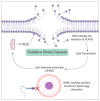Oxidative Stress in the Male Germline: A Review of Novel Strategies to Reduce 4-Hydroxynonenal Production
- PMID: 30282920
- PMCID: PMC6209867
- DOI: 10.3390/antiox7100132
Oxidative Stress in the Male Germline: A Review of Novel Strategies to Reduce 4-Hydroxynonenal Production
Abstract
Germline oxidative stress is intimately linked to several reproductive pathologies including a failure of sperm-egg recognition. The lipid aldehyde 4-hydroxynonenal (4HNE) is particularly damaging to the process of sperm-egg recognition as it compromises the function and the stability of several germline proteins. Considering mature spermatozoa do not have the capacity for de novo protein translation, 4HNE modification of proteins in the mature gametes has uniquely severe consequences for protein homeostasis, cell function and cell survival. In somatic cells, 4HNE overproduction has been attributed to the action of lipoxygenase enzymes that facilitate the oxygenation and degradation of ω-6 polyunsaturated fatty acids (PUFAs). Accordingly, the arachidonate 15-lipoxygenase (ALOX15) enzyme has been intrinsically linked with 4HNE production, and resultant pathophysiology in various complex conditions such as coronary artery disease and multiple sclerosis. While ALOX15 has not been well characterized in germ cells, we postulate that ALOX15 inhibition may pose a new strategy to prevent 4HNE-induced protein modifications in the male germline. In this light, this review focuses on (i) 4HNE-induced protein damage in the male germline and its implications for fertility; and (ii) new methods for the prevention of lipid peroxidation in germ cells.
Keywords: 4-hydroxynonenal (4HNE); arachidonate 15-lipoxygenase (ALOX15); lipid peroxidation; male fertility; oxidative stress; reactive oxygen species (ROS).
Conflict of interest statement
The authors declare that there is no conflict of interest.
Figures


Similar articles
-
Molecular Changes Induced by Oxidative Stress that Impair Human Sperm Motility.Antioxidants (Basel). 2020 Feb 4;9(2):134. doi: 10.3390/antiox9020134. Antioxidants (Basel). 2020. PMID: 32033035 Free PMC article. Review.
-
Inhibition of arachidonate 15-lipoxygenase prevents 4-hydroxynonenal-induced protein damage in male germ cells.Biol Reprod. 2017 Mar 1;96(3):598-609. doi: 10.1093/biolre/iox005. Biol Reprod. 2017. PMID: 28339608
-
Pharmacological inhibition of arachidonate 15-lipoxygenase protects human spermatozoa against oxidative stress.Biol Reprod. 2018 Jun 1;98(6):784-794. doi: 10.1093/biolre/ioy058. Biol Reprod. 2018. PMID: 29546268
-
Proteolytic degradation of heat shock protein A2 occurs in response to oxidative stress in male germ cells of the mouse.Mol Hum Reprod. 2017 Feb 10;23(2):91-105. doi: 10.1093/molehr/gaw074. Mol Hum Reprod. 2017. PMID: 27932549
-
Building an Understanding of Proteostasis in Reproductive Cells: The Impact of Reactive Carbonyl Species on Protein Fate.Antioxid Redox Signal. 2024 Aug;41(4-6):296-321. doi: 10.1089/ars.2023.0314. Epub 2024 Mar 25. Antioxid Redox Signal. 2024. PMID: 38115641 Review.
Cited by
-
Molecular Changes Induced by Oxidative Stress that Impair Human Sperm Motility.Antioxidants (Basel). 2020 Feb 4;9(2):134. doi: 10.3390/antiox9020134. Antioxidants (Basel). 2020. PMID: 32033035 Free PMC article. Review.
-
Male infertility and somatic health - insights into lipid damage as a mechanistic link.Nat Rev Urol. 2022 Dec;19(12):727-750. doi: 10.1038/s41585-022-00640-y. Epub 2022 Sep 13. Nat Rev Urol. 2022. PMID: 36100661 Review.
-
Antioxidants and Second Messengers of Free Radicals.Antioxidants (Basel). 2018 Nov 6;7(11):158. doi: 10.3390/antiox7110158. Antioxidants (Basel). 2018. PMID: 30404130 Free PMC article.
-
Measuring Reactive Oxygen Species in Semen for Male Preconception Care: A Scientist Perspective.Antioxidants (Basel). 2022 Jan 28;11(2):264. doi: 10.3390/antiox11020264. Antioxidants (Basel). 2022. PMID: 35204147 Free PMC article. Review.
-
Cinobufagin Suppresses Lipid Peroxidation and Inflammation in Osteoporotic Mice by Promoting the Delivery of miR-3102-5p by Macrophage-Derived Exosomes.Int J Nanomedicine. 2024 Oct 18;19:10497-10512. doi: 10.2147/IJN.S483849. eCollection 2024. Int J Nanomedicine. 2024. PMID: 39439501 Free PMC article.
References
Publication types
Grants and funding
LinkOut - more resources
Full Text Sources

